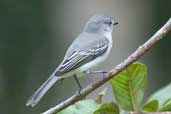
March 2004
The Atlantic Grey Elaenia is a forest flycatcher found in central and east Brazil and adjacent areas of Bolivia, Paraguay and Argentina.See the distribution map at Birdlife International.
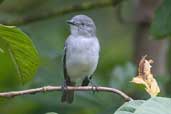
The male, seen in photos 1 to 3, is all grey above and has a white crown patch which is normally concealed. The wings are black with 2 white wingbars and broad white edges to the tertials. Below it is pale grey moving to white on the belly.
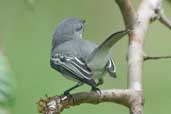
They are often seen with canopy mixed flocks. They tend to perch fairly erect and sometimes cock their tail as in photo 3.
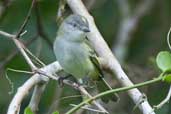
There are illustrations in Hilty & Brown, Plate 37; Ridgely & Tudor, Volume 2, Plate 31 and HBW Volume 9, Page 285.
What is curious about these illustrations is that eyes are depicted as dark and text references make no mention of the striking pale iris. I received the following clarification from José Fernando Pacheco (note that these were made before the split by the HBW and Birdlife International checklist into Atlantic Grey Elaenia M. caniceps and Amazonian Grey Elaenia M. cinerea:
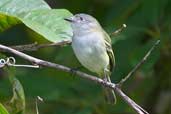
In my experience, M caniceps when well seen (not always possible since it is a bird of the canopy) in, for example, Itatiaia, Linhares and Alagoas, has pale eyes.
It is possible that only the nominate sub-species Myiopagis caniceps caniceps (central and eastern Brazil, Argentina, Paraguay) has a "brown iris with white border" (Belton. Aves do Rio Grande do Sul. 1994:284) or "whitish-grey iris" (Magalhães. Aves na Fazenda Barreiro Rico. 1999:168).
Judging by the two photos (male and female) of Myiopagis caniceps cinerea (Colombia, Ecuador, Peru and north-west Amazonian Brazil) printed in the old edition of Dunning (1982. South American Land Birds) taken of birds from Ecuador and Colombia, the iris of this population (n=2) is black or dark brown.
It is possible that age (as happens normally) also influences the iris colouration of these two sub-species."
The above is my translation of the original message from José Fernando Pacheco which reads:
"Os olhos claros de Myiopagis caniceps representam um detalhe a mais na distinção com o seu meio-sósia Phyllomyias griseocapilla, este com olhos pretos. No campo, as fêmeas de M. caniceps parecem "copiar" a coloração geral de P. griseocapilla, embora este (sem dicromatismo) tenha apenas os flancos amarelados (e não todo o ventre).
Na minha experiência, os indivíduos de M. caniceps bem vistos (o que nem sempre é possível, por ser ave da copa), p.ex. no Itatiaia, em Linhares e Alagoas, tinham olhos claros.
É possível que apenas a forma nominada Myiopagis caniceps caniceps (Brasil central e oriental, Argentina, Paraguai) possua "íris marrom, com borda branca"(Belton. Aves do Rio Grande do Sul 1994:284) ou "íris branca-cinza" (Magalhães Aves na Fazenda Barreiro Rico. 1999:168).
A julgar por duas fotografias (macho e fêmea) de Myiopagis caniceps cinerea (Colômbia, Equador, Peru e Noroeste amazônico do Brasil) estampadas na antiga edição do Dunning (1982. South American Land Birds), obtidas de aves capturadas no Equador e Colômbia, a íris desta população (n=2) é preta ou marrom escuro.
É possível que a idade (como normalmente acontece) interfira também na coloração da íris nestas duas subespécies. "
| Previous Page | Back to Index | Next Page |